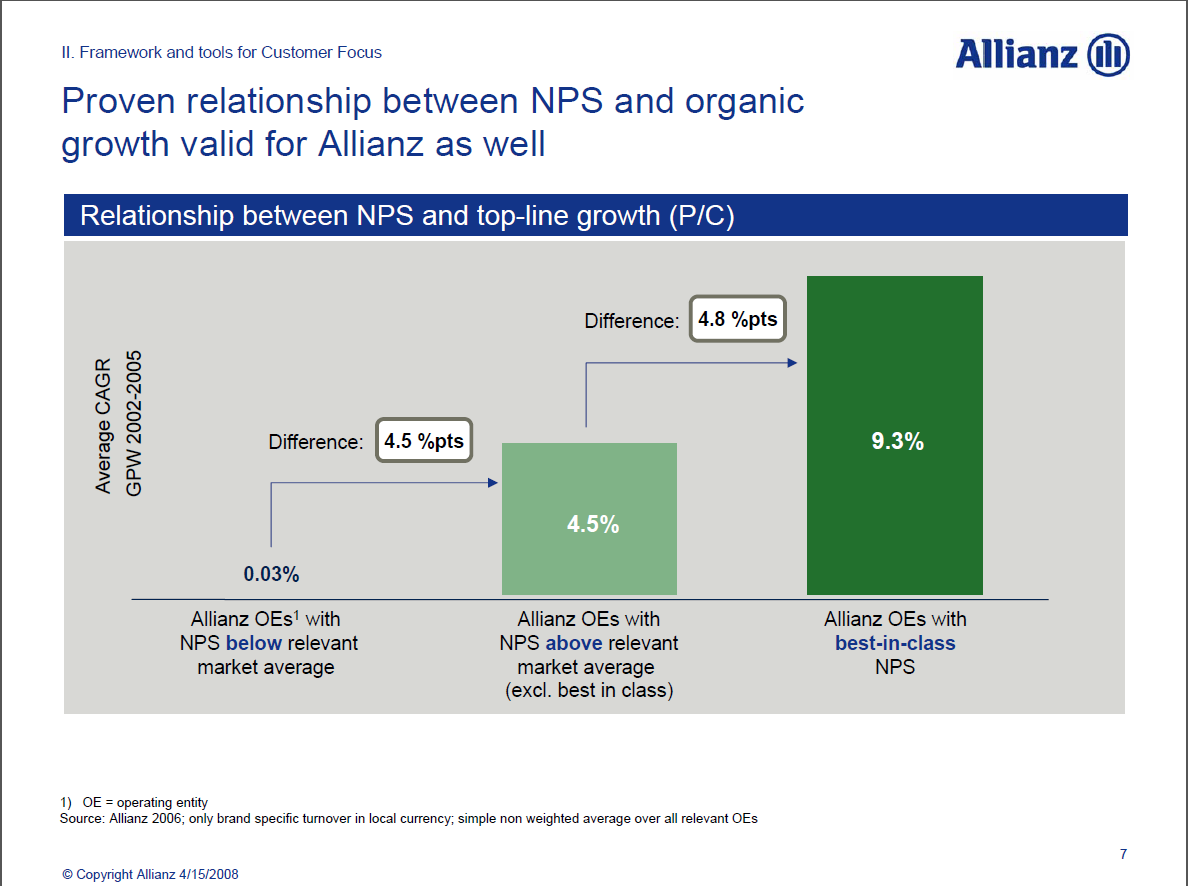

Are you wondering whether to invest in the Net Promoter Score (NPS) to improve your customer experience? The debate is rife amongst NPS evangelists and those who are more doubtful, so here I share some examples of companies who have invested in NPS and made real improvements.
(In this post, we’re only focusing on Net Promoter Score. For more on the Net Promoter System, we recommend checking out resources like Bain & Company, and Customer Strategy to name only a couple).
Numerous companies use NPS today to measure customer loyalty, and the reasons to implement NPS are many. An example is a study by Bain & Company, which established a strong link between organic growth and a company’s NPS relative to the relevant competitors in its industry.
NPS gives you a gauge as to how your customers feel about your company, but more importantly, it measures customer loyalty. It’s based on a single question about a customers’ overall interaction with a company: “How likely are you to recommend our company/product/service to your friends, family and colleagues?”.
Word-of-mouth is an age old phenomenon, but recommendations are still the best way to acquire new customers. NPS measures these recommendations, and in many industries, you can use it to compare your customers’ brand loyalty against those of your competitors’ customers. Read more about how NPS works here.
It’s simple, (some might say too simplistic) but at the same time, it can still be a very relevant metric for all levels of an organization. It’s a “simple” solution (in the sense that you get a great return for little effort) to a complicated matter.
1. Increased customer loyalty
In 2016, the Temkin Group published research that found a strong link between NPS (the system) and customer loyalty. After analyzing 291 companies in 20 industries it established the value of NPS. The research showed that promoters are a business’ greatest asset and are:
As Temkin also states, NPS helps businesses make smart, informed decisions. Still, the Net Promoter Score is just a calculation of how your current performance in the minds of customers.
To make NPS a success you need to ensure everyone across the organisation has access to customer feedback. And crucially that your business implements processes to address customer feedback, and continually close the loop with your customers to let them know how you have implemented their feedback.
2. Gain insights from your customer feedback
Studies show that over 78% of purchase decisions are made based on peer-to-peer recommendations, while only 14% are based on advertisements. I reckon this human inclination to share your customer experiences will not go away, so best know how to leverage it to your advantage.
The focus should be on the insights you learn from your customer feedback, and less on the actual score.
So, implementing the Net Promoter Score (for example through sending surveys and gathering the feedback) is a first step to be able to gain insights and leverage your feedback. But it’s not everything.
As an example, if you did five things to try increase the NPS metric and it did increase, how do you know which of the things worked and got noticed? The score alone won’t tell you. But the customer feedback will.
At Thematic, we help our clients increase their NPS over time, by identifying what’s causing the issues so that they can address it straight away.
3. Indicator and driver of future growth
“The beauty of Net Promoter,” says Charles Schwab, CEO of Walt Bettinger, “is that it simplifies complex issues and helps people make the right decisions” (Forbes).
And as Bill Macaitis, CMO of Slack, says in relation to SaaS companies: “One metric that most SaaS marketers don’t measure frequently, but should, is Net Promoter Score. NPS measures the likelihood of customers to recommend the product. Best in class companies achieve a score of 70 on a scale of 100, but according to Zendesk data, the typical B2B software company achieves only 29. NPS is a leading indicator of future growth. The larger the number of advocates for the product, the lower the customer acquisition costs for the company, and the more effective customer success team will be.”
If you need to provide a business case for NPS, you might take the following into consideration.
As Genroe writes, it’s proven that promoters buy more than detractors and are more loyal (which makes sense) so you can estimate the value derived from moving some detractors to neutral or promoter status.
They also mention a well-documented effect called the survey effect. Morwitz states that people who are surveyed about their customer experience typically purchase more and stay longer than those that don’t (“The effect of survey measurement on respondent behaviour”, Morwitz, 2005).
And, continues Genroe, because NPS is focused on continuous improvement, it can identify ways to dramatically reduce costs.
Having the data to back up your suspicions about what is causing your bottlenecks will be invaluable. A strong customer feedback process provides objective information on what your customers really want.
Instead of spending time debating what your people think customers want, you will actually know. And since you’ll have data to facilitate decision making you’re able to prioritise better.
When gathering feedback you might well uncover new business opportunities that you might never have known about, I’ve heard plenty of examples of customers who do, and go on to developing a whole new product line based on feedback alone.
1. How Symantec reduces costs
Symantec is a global software company addressing security risks as well as risks to compliance, performance, and availability. Before adopting NPS in 2004, each department had its own metrics, although they didn’t help improve customer loyalty. It deployed NPS in the Consumer Business Unit (CBU), which is responsible for developing and marketing its Norton products which represent more than 30% of the company’s revenue.
After introducing NPS, the CBU achieved more than 50% increase in NPS for its Norton Internet Security and Antivirus product lines.
Symantec also achieved a 10 to 12% reduction in call times and a 13-point improvement in satisfaction scores for Support, to name just a few of the positives. Still today, NPS is integrated into Symantec’s business, and a big part of its customer-centric culture.
2. Allianz shows there is a link between NPS and organic growth
Allianz is an international financial services provider based in Germany. When Allianz adopted NPS, there was a high customer acceptance of the survey. 91% participated in the NPS survey and 85% accepted a feedback call from an Allianz employee.
The company implemented a bottom-up NPS complemented by service recovery. The goal of Allianz was to turn detractors into promoters. Allianz found that operating units with a high NPS had a higher overall CAGR (compound annual growth rate) compared to units with lower overall NPS scores:

NPS vs Organic Growth: Allianz
3. Philips methodology for how new products impacts NPS
An older, but still relevant example is Philips, who put in place a methodology to determine how new products would contribute and influence NPS ratings. Products indicating a high NPS rating potential progress along the development process. And if they don’t, they go back to the drawing board to be worked on until they reach a sufficient standard, or even killed.
To ensure NPS worked, Philips launched the Reference Promoter program. The idea is that customers who were willing to recommend the brand to actually did so. They capture customers’ testimonials on video and create case studies. These are then leveraged by the sales force to target responses and ultimately increase sales. If a customer wants to learn more about how Philips manages relationships, they pick a relevant testimonial and showcase that to them. In Philip’s view, this brings NPS into the space of driving business growth.
4. Airbnb connects higher NPS to more referrals and rebookings
Airbnb kicked off their NPS program in 2013. Their goal was to see how NPS could add value to their feedback program and establish if there is a link between NPS and the likelihood that the guest would return to book another stay, recommend the unique service, and resist engaging deals and competitor offers.
The research involved feedback from 600,000 guests who booked a stay with Airbnb between January and April of 2014. Two-thirds of the guests who submitted feedback were promoters and over 300,000 of them gave Airbnb a score of 10. Just 2% of guests were detractors!
Airbnb found that guests who were promoters were statistically more likely to both book another stay and refer a friend or family member (via their “Invite a friend feature”). Interestingly they also discovered that while a guest may not have been satisfied with a particular stay, 26% were still promoters of Airbnb, reinforcing the need to go beyond just CSAT on a per transaction or booking level.
1. Use NPS as a product development tool
Use NPS to determine if your customers like the service you provide but also how well your products perform. It can be a reliable leading indicator of growth in word-of-mouth referrals, which is a huge marketing channel.
For example, if you notice that your NPS goes down for a particular product, it’s a red flag that something is very wrong. The dip can help explain any problems your customers are having, especially if you also collect and analyze free-text feedback on the back of your survey. This way, you can get very precise information on what is wrong and be able to address it straight away.
2. Use NPS to reduce churn and drive growth
Assign a person or a team who is responsible for the Customer Success team, with their main focus being monitoring NPS and alerting any issues.
The team’s main purpose is in actual fact to reduce churn, so reacting quickly to complaints is critical. This is especially true if you only survey NPS once or twice a year, as then you run the risk of making it nearly impossible to track how customers were doing in real-time. Many issues will go unnoticed and left to worsen. You can use different apps that alert you about any at-risk customers so you can respond ASAP.
By tracking which customers give high scores you can target customers who are more likely to be responsive for cross-sells and upsells.
By using NPS, you can be on the way to a customer-centric organizational culture where you’re continually improving. NPS is constantly moving, so use it to track shifts in response to your actions or inaction, and also competitor initiatives.
Yes, NPS is a good starting point if you’re needing an indication of your CX performance but it is not the be-all-and-end-all of metrics (none of them are!).
Some companies start off with implementing the NPS metric as a benchmark score, and thereafter adopt more refined measures and an organisational culture focusing on data-driven results.
Regardless if you implement NPS (or another metric for that matter) or not, the value lies in the insights you find in the NPS surveys (not the score itself). Making a change where you experience issues and driving improvements is what’s important.
As Shep Hyken writes, the NPS measurement means nothing unless you do something with it. And, as Temkin says, “Instead of obsessing about the specific metric being used, companies need to obsess about the system they put in place to make changes based on what they learn from using the metric.”
It’s through the insights gathered (and correctly analyzed) that you will make the biggest impact and change.
Join the newsletter to receive the latest updates in your inbox.